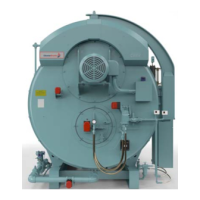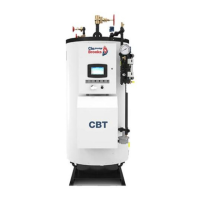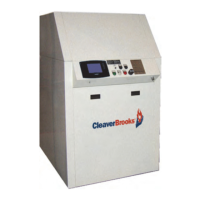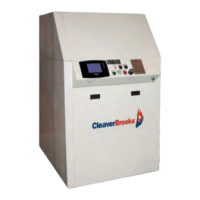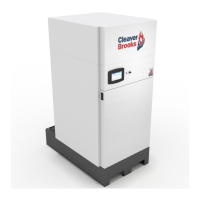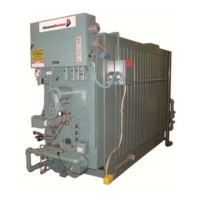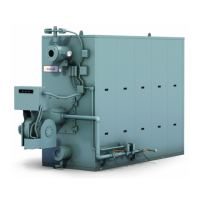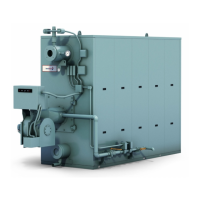750-368
CBEX Elite 100-1200 HP
3-11
3.7 — Blowdown: Steam Boiler
A controlled orifice valve or an auto-sensing/metering valve is used to allow a continual, yet controlled flow of
concentrated water to drain or a place of recovery.
The flow control valve and piping are generally provided by others. All piping must be routed to a safe point of
discharge.
3.7.2 — Frequency of Manual Blowdown
When continuous blowdown is utilized, manual blowdown is primarily used to remove suspended solids or
sludge. The continuous blowdown removes sediment and oil from the surface of the water along with a pre-
scribed amount of dissolved solids.
When surface or continuous blowdown is not utilized manual blowdown is used to control the dissolved or sus-
pended solids in addition to the sludge. This will involve chemical treatment to sequester the TDS.
In practice, the valve(s) of the bottom blowdown are opened periodically in accordance with an operating sched-
ule and/or chemical control test. From the standpoint of control, economy and results, frequent short blows are
preferred to infrequent lengthy blows. The length and frequency of the blowdown is particularly important when
the suspended solids content of the water is high. With the use of frequent short blows a more uniform concen-
tration of the pressure vessel water is maintained.
In cases where the feedwater is exceptionally pure, or where there is a high percentage of return condensate,
Blowdown may be employed less frequently since less sludge accumulates in the pressure vessel. When dis-
solved and/or suspended solids approach or exceed predetermined limits, manual blowdown to lower the con-
centrations is required.
It is generally recommended that a steam boiler be blown down at least once in every eight-hour period, but fre-
quency may vary depending upon water and operating conditions. The blowdown amounts and schedule should
be recommended by your local Cleaver-Brooks authorized representative.
A hot water boiler does not normally include openings for surface and bottom blowdown since blowdowns are
not practiced. The need remains to be alert to system water losses and corresponding amount of raw water
make-up. A water meter is recommended for water make-up lines.
3.7.3 — Manual Blowdown Procedure
Blowdown is most effective at a point when the generation of steam is at the lowest rate and feedwater input is
also low.
Be sure the blow-off piping and tank, if used, are in proper operating condition. Discharge vents should be clear of
obstruction, and the waste should be piped to a point of safe discharge.
If a quick opening valve and globe type slow opening valve are in combination, the former is normally opened
first and closed last with blow down accomplished with the globe or slow opening valve.
Larger vessels may have two or three bottom blowdown lines, each with a quick opening valve. Lines may be
blown down simultaneously by opening all quick opening valves before opening the downstream valve.
When opening the slow opening valve, crack it slightly to allow the lines to warm, then continue opening slowly.
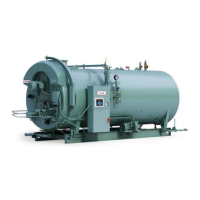
